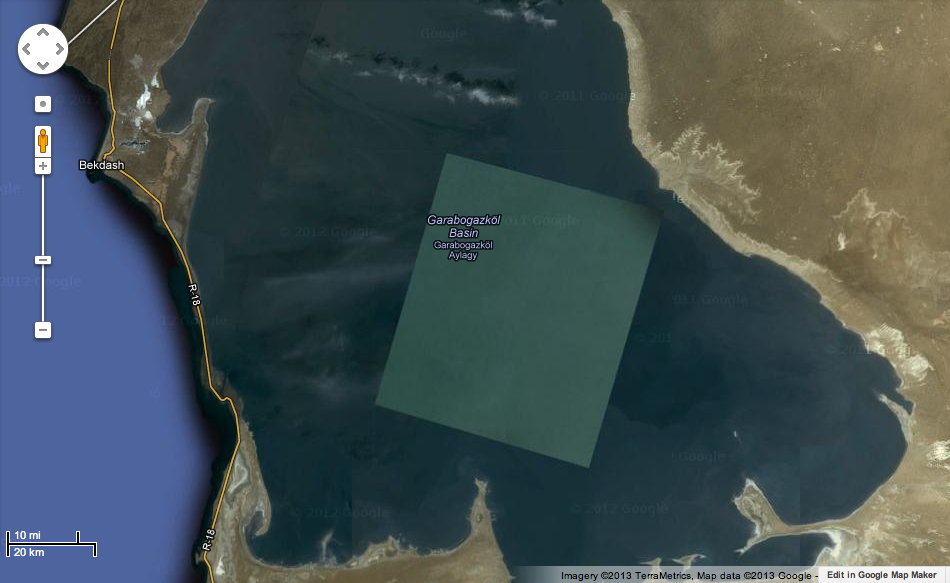!["Lop Nur, Xinjiang, China" by Jesse Allen and Robert Simmon (NASA Earth Observatory) [Public domain], via Wikimedia Commons 588px-Lop_Nur,_Xinjiang,_China](http://crypticphilosopher.com/wp-content/uploads/2012/11/588px-Lop_Nur_Xinjiang_China-294x300.jpg)
An ironman triathlon swim would not make it halfway across the *width* of this thing.
About a year ago,
Gizmodo had an article entitled
“Why Is China Building These Gigantic Structures In the Middle of the Desert?” I only noticed the article a few weeks ago, but it piqued my curiosity and provided a much-needed distraction from inarguably-more-important work. In addition to a variety of
giant complexes of lines on the ground in the desert of western China (sort of like non-artistic
Nazca lines, but not really), there is what appears to be a
giant pool next to a complex of industrial buildings. By giant, I really do mean ginormous. This thing is probably 8 miles long by 5 miles wide.
The imaginative possibilities are nearly endless. The thing is located in the Lop Nur basin, a dried-up salt lake and nuclear test site in the Xinjiang Uygur Autonomous Region of western China. It doesn’t seem to be near much of anything, except for one road. Several straight lines, which appear to be canals, extend north out of the pools for miles. In the industrial complex, which is probably huge but seems tiny compared to the gigantic pools, are two large cooling towers, often seen in nuclear power plants.
View Larger MapWhat could it be? I admit, I was kind of hoping for an underwater
ghost city.
Somewhat disappointingly, the actual answer was not that hard to find. Even more disappointing was that I partly found it on Wikipedia.
Well, I found the publicly available answer, anyway. If the history of government subterfuge has taught us anything, it’s that the truth usually isn’t any more interesting than the cover story. I can’t say that this is a “cover story,” but let’s cling to what little intrigue we can.
I’ll spare you any further dramatic tension: it’s a fertilizer plant. Yes, this giant complex of pools in the middle of a vast desert is there to exploit sylvite resources in the area to extract potassium chloride to make potash fertilizers. I had hoped that it was a training ground for human-fish hybrids, in preparation for colonization of the Pacific floor, but really, a fertilizer plant covering around forty square miles of desert is pretty impressive, too. NASA describes the site as follows:
Located in China’s resource-rich but moisture-poor Xinjiang autonomous region, Lop Nur is an uninviting location for any kind of agriculture. It sits at the eastern end of the Taklimakan Desert, where marching sand dunes can reach heights of 200 meters (650 feet), and dust storms rage across the landscape.
Yet for all it lacks in agricultural appeal, Lop Nur offers something valuable to farmers the world over: potash. This potassium salt provides a major nutrient required for plant growth, making it a key ingredient in fertilizer.
The discovery of potash at Lop Nur in the mid-1990s turned the area into a large-scale mining operation. The Advanced Land Imager (ALI) on NASA’s Earth Observing-1 (EO-1) satellite captured this natural-color image of Lop Nur on May 17, 2011. The rectangular shapes in this image show the bright colors characteristic of solar evaporation ponds. Around the evaporation ponds are the earth tones typical of sandy desert.
!["Kaliumchlorid-Feld in der Wüste Lop Nor" by NASA. [Public domain], via Wikimedia Commons 386px-Kaliumchlorid-Feld_in_der_Wüste_Lop_Nor](http://crypticphilosopher.com/wp-content/uploads/2012/11/386px-Kaliumchlorid-Feld_in_der_Wüste_Lop_Nor-193x300.jpg) An earlier picture of the site appears on the German-language Wikipedia page, with this somewhat-broken-English description:
An earlier picture of the site appears on the German-language Wikipedia page, with this somewhat-broken-English description:
The world’s largest potash fertilizer production base in the size 10 to 21 km is built in the former Lake Lop Nur, Xinjiang, China. The first phase of the project which has an annual capacity of 1.2 million tons was put into operation on Dec.18, 2008. The second phase with an annual capacity of 1.7 million tons has been launched 2009 and will be operational in 2014. The 3 million program will make Lop Nor the largest potash fertilizer production base in the world. The Project of Development and Utilization of Sylvite Resources in Lop Nur region employs the technique of producing potassium sulphate through magnesium sulfate subtype brine, which filled a technological gas of this kind and made China among the fewer countries that could produce potassium sulphate from brine directly taken from salt lake. The satellite picture is taken 2009-10-12.
!["Lop Nur and the potash fertilizer production plant 2009" by NASA [Public domain], via Wikimedia Commons 800px-Lop_Nur_and_the_potash_fertilizer_production_plant_2009](http://crypticphilosopher.com/wp-content/uploads/2012/11/800px-Lop_Nur_and_the_potash_fertilizer_production_plant_2009.jpg)
I guess it’s hard to keep big things secret anymore, although I’m still not sure if this was ever meant to be secret. I found another picture of what appears to be a separate site in the area, described as a “salt field”:
!["Salt field in the Lop Nur Desert" by NASA. [Public domain], via Wikimedia Commons Salt_field_in_the_Lop_Nur_Desert](http://crypticphilosopher.com/wp-content/uploads/2012/11/Salt_field_in_the_Lop_Nur_Desert.jpg)
China, Xinjiang, desert Lop Nur. Satellite picture of the Lop Desert with the Basin of the formerly sea Lop Nur. You see the Salt field by the Lop Nur Sylvite Science and Technology Development Co. Ltd.
Based on some archived articles, China began the process of extracting sylvite from the region in 2001, expecting to find reserves of up to 250 million tons. The country made a “major breakthrough” in techniques to extract at use the mineral in 2004, and it began setting up the facility around the same time. The first phase of the facility became operational on December 18, 2008, with a capacity of producing 1.2 million tons of fertilizer per year. The second phase, which will produce 1.7 million tons annually, is supposed to go online this year.
On the other hand, it could be a prototype for China’s first ringworld, to test out ocean structures…
Photo credits: “Lop Nur, Xinjiang, China” by Jesse Allen and Robert Simmon (NASA Earth Observatory) [Public domain], via Wikimedia Commons; “Kaliumchlorid-Feld in der Wüste Lop Nor” by NASA. [Public domain], via Wikimedia Commons; “Lop Nur and the potash fertilizer production plant 2009” by NASA [Public domain], via Wikimedia Commons; “Salt field in the Lop Nur Desert” by NASA [Public domain], via Wikimedia Commons






!["Monkey Sea, Monkey Do" by *JaxGraphix [CC BY-NC-ND 3.0], via deviantart.com Monkey_Sea__Monkey_Do_by_AbandonedUntilDeath](http://crypticphilosopher.com/wp-content/uploads/2013/03/Monkey_Sea__Monkey_Do_by_AbandonedUntilDeath.jpg)
!["Lop Nur, Xinjiang, China" by Jesse Allen and Robert Simmon (NASA Earth Observatory) [Public domain], via Wikimedia Commons 588px-Lop_Nur,_Xinjiang,_China](http://crypticphilosopher.com/wp-content/uploads/2012/11/588px-Lop_Nur_Xinjiang_China-294x300.jpg)
!["Kaliumchlorid-Feld in der Wüste Lop Nor" by NASA. [Public domain], via Wikimedia Commons 386px-Kaliumchlorid-Feld_in_der_Wüste_Lop_Nor](http://crypticphilosopher.com/wp-content/uploads/2012/11/386px-Kaliumchlorid-Feld_in_der_Wüste_Lop_Nor-193x300.jpg)
!["Lop Nur and the potash fertilizer production plant 2009" by NASA [Public domain], via Wikimedia Commons 800px-Lop_Nur_and_the_potash_fertilizer_production_plant_2009](http://crypticphilosopher.com/wp-content/uploads/2012/11/800px-Lop_Nur_and_the_potash_fertilizer_production_plant_2009.jpg)
!["Salt field in the Lop Nur Desert" by NASA. [Public domain], via Wikimedia Commons Salt_field_in_the_Lop_Nur_Desert](http://crypticphilosopher.com/wp-content/uploads/2012/11/Salt_field_in_the_Lop_Nur_Desert.jpg)
!["Azadi Monument" [GFDL (www.gnu.org/copyleft/fdl.html) or CC-BY-SA-3.0 (http://creativecommons.org/licenses/by-sa/3.0/)], from Wikimedia Commons Azadi_Monument](http://crypticphilosopher.com/wp-content/uploads/2012/10/Azadi_Monument-300x225.jpg) The group
The group !["Soviet War Memorial Northwest view 1" by Zael (Own work) [CC-BY-SA-3.0 (http://creativecommons.org/licenses/by-sa/3.0)], via Wikimedia Commons 320px-Soviet_War_Memorial_Northwest_view_1](http://crypticphilosopher.com/wp-content/uploads/2012/10/320px-Soviet_War_Memorial_Northwest_view_1-300x200.jpg) – Last week, I mentioned a college student who got near-fatal alcohol poisoning from pouring cheap wine up his butt. This week, I learned about a teenager in England who had to have part of her stomach removed after
– Last week, I mentioned a college student who got near-fatal alcohol poisoning from pouring cheap wine up his butt. This week, I learned about a teenager in England who had to have part of her stomach removed after  – A fan of right-wing faux-historian David Barton
– A fan of right-wing faux-historian David Barton